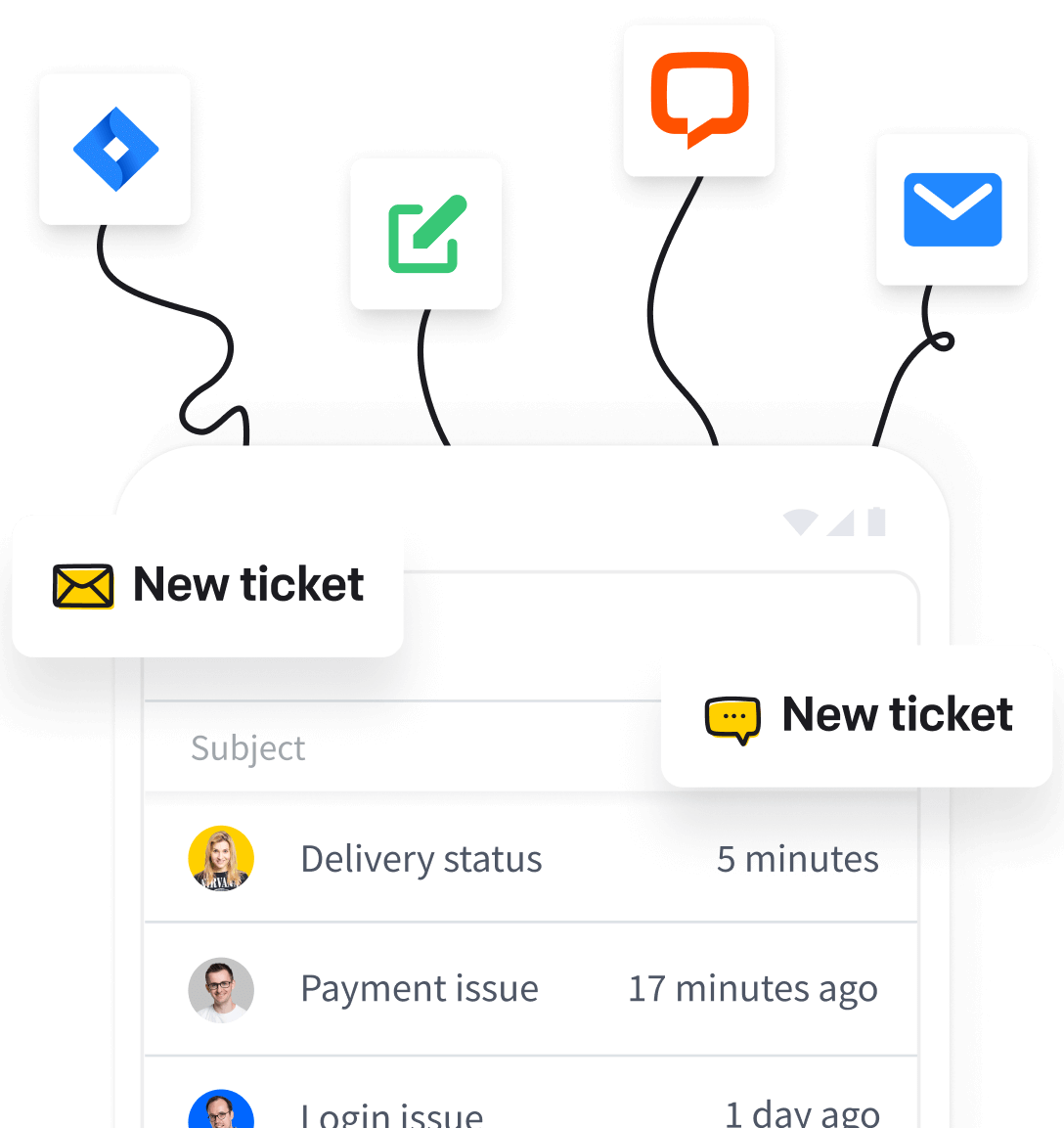Weronika Masternak

Customers are the cornerstone of a business, essential for its growth, success, and stability in the market. To keep end-users happy and satisfied, companies should go beyond clichéd phrases and merely meet expectations – they should focus on exceeding them.
One thing that greatly helps in this is first contact resolution (which can be tracked in the help desk system). FCR allows organizations to address customer issues promptly, offering an excellent customer experience.
This is especially crucial for the success of a business. The survey shows that 83 percent of respondents considered good customer service an essential or critically important driver of brand loyalty.
This article guides you about first contact resolution, its importance, and strategies to improve the FCR of your business. Let’s dig in!
What is first contact resolution?
First contact resolution (or first call resolution) is a customer satisfaction metric that tells the percentage of inquiries resolved in first contact or try. It’s the ability of the customer service team members to address and resolve a customer’s issue during their initial contact with the company.
Efficient FCR eliminates the need for further follow-up or escalation. The objective is to boost customer satisfaction by offering timely and effective solutions to their problems. Hence, this minimizes frustration and ensures a positive experience.
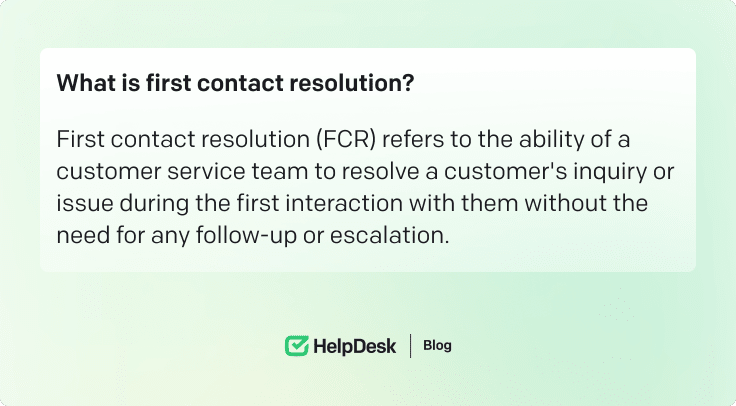
Try HelpDesk for free, browse the first response time report, and see how quickly you handle requests from your recipients. Then, watch your satisfaction soar! 🚀
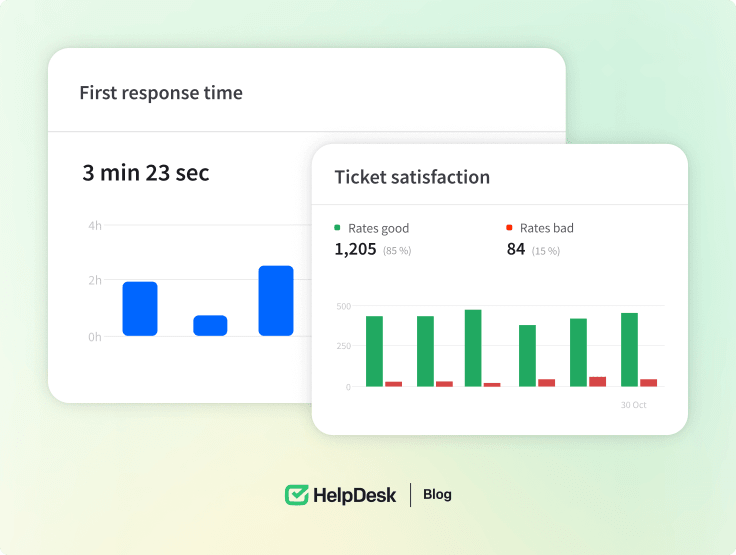
Understanding first contact resolution
Customers expect efficient and effective resolution of their issues or concerns when they reach out to a company for assistance. This is where first call resolution takes center stage, shaping customer experience.
The following points further highlight why FCR is important:
Helps retain customers
According to Zippia Research, 72% of customers go to a competitor after a bad experience with a brand. Yes, it’s true! Therefore, businesses are trying their best to offer a premium customer experience that ultimately leads to increased sales.
The first call resolution proves to be helpful in this situation by showcasing commitment to customer service excellence. And when your customers feel heard and valued, they don’t seek alternative solutions or switch to competitors. This results in high customer retention, contributing to long-term business success and profitability.
Increases the willingness to spend
Another thing that first contact resolution does is increase the willingness of customers to spend on your brand. It provides them with a seamless and satisfactory customer service experience.
When customers get their issues resolved on the first customer interactions, they take the brand as a reliable and responsive one. This gives them a sense of confidence in their purchasing decisions. Hence, you see a spike in your sales and overall revenue.
Changes the minds of dissatisfied customers
If a customer is dissatisfied with your support agents, they stop connecting with your brand and share their poor customer service experience with others. There’s a famous saying, “A word of mouth goes a long way.” So, any bad customer experience can quickly spread and tarnish the reputation of your business. Remember, Superoffice states that 13% of unhappy customers will share their complaints with 15 friends or more.
Putting first call resolution in place can be a breakthrough in such scenarios. It helps you promptly change customer perception about your brand. Instead of a bad word of mouth, customers may share their positive experiences with others. This helps repair any damage to the brand’s reputation and even attracts new customers.
Implementing FCR directly addresses customer concerns and brings several benefits to the organization. It’s a critical remote support component, enabling businesses to resolve issues without needing multiple interactions. This efficiency not only boosts customer satisfaction but also reduces operational costs.
To achieve these benefits, adhering to best practices in FCR is crucial. Training staff to handle a wide range of issues, utilizing technology to gather customer history, and empowering employees to make decisions can significantly enhance the effectiveness of FCR. By incorporating these elements, businesses can ensure a superior customer service experience, fostering loyalty and encouraging positive word-of-mouth.
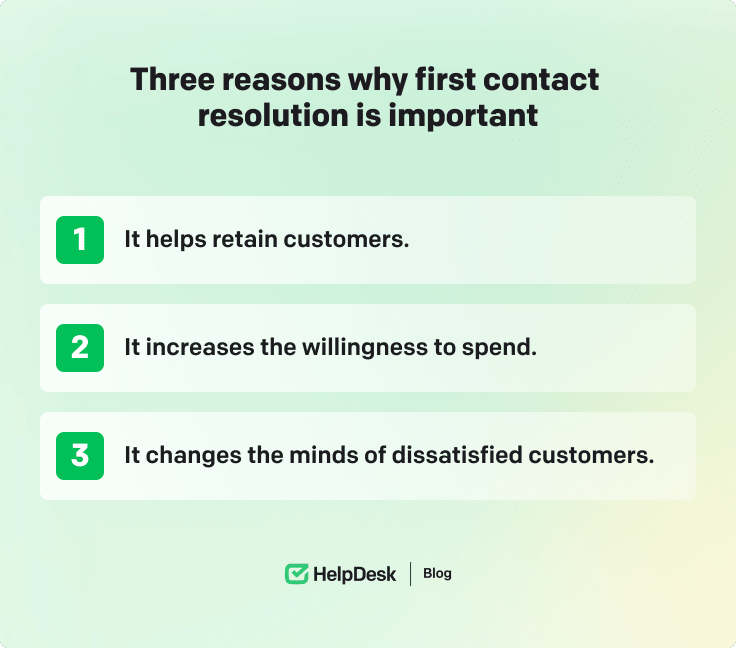
First contact resolution vs first-level resolution
Many often confuse first call resolution with first level resolution, but these terms differ. Here’s an overview of both to help you distinguish better:
First contact resolution, often evaluated through the first level resolution KPI, is the percentage of customer inquiries resolved at the first level of customer support. It doesn’t need to escalate to higher levels or additional follow-up. This metric is crucial in evaluating the efficiency of the initial support level and adhering to sector-specific customer service measures.
First level resolution is the percentage of customer inquiries addressed during the initial interaction with the customer support team, regardless of the level of support involved. The first contact resolution KPI is essential for measuring the effectiveness of the entire customer support process in resolving issues at the first point of contact, reflecting the industry standards for overall customer satisfaction.
Let’s understand the difference between first contact resolution and first level resolution through an example:
Situation 1:
A level 1 customer representative receives a complaint from a customer-facing issue in product purchase. The representative logs a ticket for a customer complaint but lacks the expertise to provide an immediate solution. Instead of escalating, they research the issue, identify a solution, and personally call back the customer to resolve the issue, closing the ticket at level 1.
Situation 2:
The level 1 customer representative takes the call and lacks the technical expertise required to solve the issue. They transfer the customer call to a level 3 IT professional. The level 3 IT professional resolves the customer issue by providing a comprehensive solution to the problem. The issue is addressed at first contact but not at level 1.
Measuring the first contact resolution KPI
Let’s see how you can calculate the success or effectiveness of your first contact resolution strategy:
Decide on FCR criteria
Firstly, you should establish criteria that help you calculate the effectiveness of your first call resolution. Make a list of things that may impact your FCR.
Some questions or variables that can be part of the list are:
-
Is first call resolution limited to live contacts who call your company or those who reach out through the customer service portal?
-
Does “sufficiently resolved” imply both problem resolution and customer satisfaction?
-
Do escalated calls encompass instances where a manager intervenes (whisper coaching, call barging, etc.)?
-
Do escalated calls include situations where a colleague is conferenced in?
-
Do repeat calls cover contacts made via chat or email?
-
Can FCR be influenced when a caller reaches the wrong department?
-
Can first call resolution be impacted by errors in a caller’s survey response?
-
What defines repeat calls?
Clearly describe your first call resolution criteria. Include all these things when making the final report.
Set a contact window
A contact window is another thing to do to measure FCR. It’s the maximum time allowed between calls for them to count towards FCR. In other words, it’s the timeframe in which two subsequent calls from the same customer will be considered part of the first contact resolution. When a call is received after this set time limit, it’s a different contact, not a part of FCR.
For instance, if the time you’ve set for a follow-up call after the first contact resolution is two days and the customer calls on the 3rd day, it won’t affect the FCR calculation. The internal FCR rate is based on whether a customer calls back for the same issue within 1 to 30 days. But other than this, there’s no standard timeframe to consider a call as first call resolution, and it varies by industry.
Use HelpDesk to send automated follow-ups instantly when certain conditions are met. It's convenient, quick, and free to test for 14 days! ✅
Define an FCR formula
This is a crucial step in calculating first call resolution success. Every organization has a different formula depending upon its set criteria. However, in general, you can use the first contact resolution rate formula, given as:
First call resolution = (Cases resolved on first contact / Total number of cases) x 100%
What is a good first contact resolution?
FCR rates vary greatly depending on the industry, time of the year, and type of support center. However, a high FCR rate is anywhere between 70% and 79%, with 80% being the best in class. The average industry first call resolution rate is around 68%. If your business’s first call resolution rate is below 30%, it needs improvement.
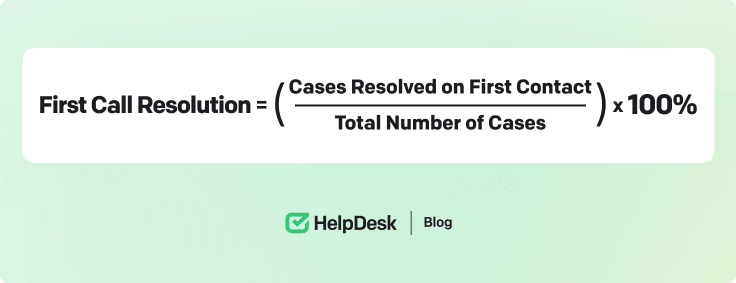
Customer follow-up surveys or emails
Another way to track FCR is to use post-call survey method options like follow-up questionnaires or ranking surveys and emails. These help calculate FCR as they provide you with customer feedback. You can easily assess customer satisfaction levels.
You get to know the percentage of customers whose issues were resolved in the first contact. This information helps your support team evaluate the first call resolution’s performance and provides insights into areas for improvement.
Improving first contact resolution
Here are some strategies that help you improve your FCR efforts:
Pinpoint the issue
The first step in improving the FCR rate is to pinpoint your issues. Find out why call center agents aren’t achieving first contact resolutions consistently. This may involve analyzing call logs, customer feedback, and agent performance metrics to identify common challenges or recurring problems.
The following are the questions you may need to ask to get an idea of the issue:
-
What is the reason behind call transfers? Are calls directed to the wrong department’s contact center when customers contact us?
-
Why are calls being escalated to managers?
-
Do customer support teams or agents repeat information to ensure they fully grasp the customer’s issue?
-
Why are interactions spanning across multiple channels? Is it due to customers experiencing difficulty reaching us via phone calls?
-
What explanations do customers provide for their dissatisfaction?
Give your agents the right training and resources
The customer support team or agents often lack adequate information to address a customer inquiry. You should equip your customer support agents with skills and omnichannel capabilities to access customer requests seamlessly. When agents clearly understand customer concerns, they can resolve issues promptly.
In addition, provide them with proper training on using the CRM and other base data systems efficiently. This focus on agent training will help them extract desired data without spending too much time, ultimately building customer relationships. You also see a positive impact on your overall first call resolution efforts.
Reward your agents
The key to a good FCR rate and great customer service is the efficiency of your customer center agents. You should reward your support department to ensure these agents work to their full capacity and put their utmost effort into addressing customer queries. You can do it in the form of motivation by recognizing their efforts and providing positive feedback. Moreover, you can offer them incentives for their exceptional performance to keep them engaged.
These growth opportunities show that you appreciate and value their efforts. As a result, you’ll see a call center agent putting their heart into their work. They’ll take the time to properly answer the question instead of rushing to get off the call. This ultimately boosts your FCR rate.
Review your support channels and gather feedback
Another thing you should do is to sit down and review your support channels. Check and analyze customer feedback on your FCR and see the hurdles in achieving a high first contact resolution rate. Review any support requests not properly managed by contact centers and incorporate measures to improve customer satisfaction.
Here are a few questions that you and your call center manager should be looking at:
-
Are they returning because they couldn’t find answers elsewhere?
-
Do they lack confidence in the support they receive?
-
Is the complexity of your product causing them to reach out repeatedly?
Considering these things will help you find areas for improvement and positively shape the entire customer journey.

Case studies on first contact resolution
The following is a real-time example of HelpDesk software offering FCR metrics to support various top-notch companies:
Valley Driving School was struggling to handle numerous inquiries from driving school applicants and drivers. Melissa Hannam, the Director of Marketing and Customer Service Manager at Valley Driving School, found some challenges in her work pattern. The first challenge was sharing the primary inbox and managing a vast influx of emails.
“There were a bunch of things going on, especially on the weekend when the agent might not be available. Once we came in on Monday, we had a ton of messages to check out.” (Melissa Hannam)
The second challenge was switching to various communication channels like email inbox, web portal, live chat, chatbot, or Facebook to address customer concerns. The HelpDesk solutions helped the Valley Driving School address these issues, offering a smooth first contact resolution experience.
The customer support team at Valley Driving School leveraged HelpDesk features like canned responses, ticket views, tags, automated workflows, and reports. This helped them quickly respond to customer requests and queries consistently in tone, voice, and information across all communication channels. This resulted in saved time and resources.
Want to be as successful in handling customer requests like Valley Driving School? Try HelpDesk for free! 🚀
FCR in technology and service operations
FCR is applied in customer support channels like IT desk and chat support to address customer issues quickly.
Here’s a brief overview of FCR in IT desk and chat support:
FCR in IT desk
IT service desk is a single communication point for customers, employees, and business partners. The FCR desk addresses technical queries or customer problems promptly and efficiently. Agents can leverage technical tools, like ticketing systems and other resources, to diagnose customer issues and ensure a higher first call resolution rate. The problem is solved on first contact, helping in smooth customer relationship management.
FCR in chat support
FCR in chat support allows agents to provide timely and accurate customer assistance through real-time messaging. Agents utilize chatbots, canned responses, and other data systems to get an idea about customer issues. They then use customer service management chatbots or messaging features to address the customer’s concerns. The goal is to resolve the problems within the first chat session without further escalation or follow-up interactions, resulting in satisfied customers.
Summary
The future of FCR is bright with technological advancements like artificial intelligence, chatbots, and predictive analytics. These help you resolve customer inquiries quickly at first contact and achieve a better first contact resolution rate. There’ll also be a better integration of omnichannel support systems.
This offers seamless communication and swift issue resolution across multiple platforms. The result will be stronger customer relationships, improved operational efficiency, and robust business growth.


Get the cheat sheet for solving customer tickets
Join our newsletter to receive your cheat sheet and other amazing content directly in your inbox.
Success! You're one click away from the cheat sheet 👇
Open now